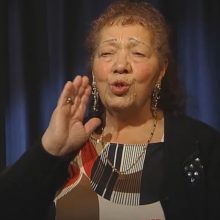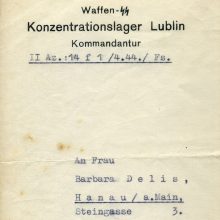The Nazi genocide of the Sinti and Roma
and the long struggle for recognition
and the long struggle for recognition
The Nazi genocide
of the Sinti and Roma and the
long struggle for recognition
of the Sinti and Roma and the
long struggle for recognition
„Racial Diagnosis:Gypsy“
The road to liberation
Many of the Sinti and Roma deported from Auschwitz-Birkenau to the Reich territory fell victim to the policy of ‘annihilation through work’ or to medical experiments conducted at the concentration camps and their many subcamps.
When Himmler gave the order to clear out the concentration camps in spring 1945, many more Sinti and Roma died on so-called ‘Todesmärsche’ [‘death marches’]. Others died of the effects of their imprisonment in concentration camps shortly after they were liberated.
To this day the survivors continue to suffer from the long-term health repercussions and the recurring traumatic memories.

01 | Minutes of Reich Minister of Justice Thierack after a meeting with Goebbels on 14 September 1942
01
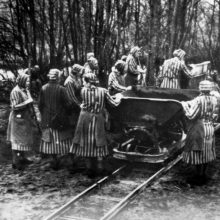
02 | Women carrying out forced labour at Ravensbrück concentration camp Archives of the Ravensbrück Memorial Site, photo no. 1699
02
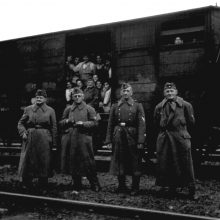
03 | Sinti and Roma women being transported out of Altenburg, probably in autumn 1944. At the subcamp of that particular concentration camp, female prisoners were used as forced labour at the Hugo Schneider AG (HASAG) armaments company. This visibly staged photograph with the guards in the foreground was taken by a HASAG engineer. Altenburg […]
03
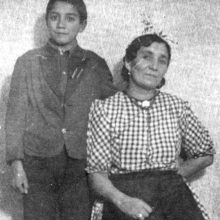
04 | Franz Rosenbach was deported to Buchenwald before the Auschwitz-Birkenau ‘gypsy camp’ was ‘liquidated’. He was sent from there to Mittelbau-Dora, where he was forced to do hard labour in underground galleries for the German armaments industry. His mother Cäcilie fell victim to the genocide. Documentation Centre Archives
04
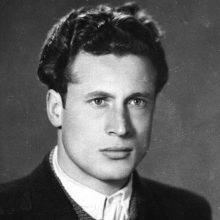
05.1 | Josef Köhler was deported from Auschwitz to Sachsenhausen via Ravensbrück and forced to do hard labour at the local ‘brickworks’. His father (next photo), who had served as a soldier in the First World War and had been seriously wounded on the front in 1939, was murdered at Sachsenhausen concentration camp. Documentation Centre […]
05.1

05.2 | Josef Köhler was deported from Auschwitz to Sachsenhausen via Ravensbrück and forced to do hard labour at the local ‘brickworks’. His father (pictured), who had served as a soldier in the First World War and had been seriously wounded on the front in 1939, was murdered at Sachsenhausen concentration camp. Documentation Centre Archives
05.2
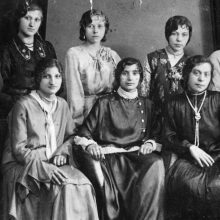
06 | Six of the women in the photograph fell victim to the genocide. Documentation Centre Archives
06

07.1 | Lisetta Rose was murdered at Ravensbrück concentration camp. The ordeal of her daughter Martha Rose (next photo) took her via Ravensbrück to Bergen-Belsen, where she was shot shortly before the end of the war. Documentation Centre Archives
07.1
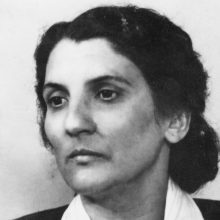
07.2 | Lisetta Rose was murdered at Ravensbrück concentration camp. The ordeal of her daughter Martha Rose (pictured) took her via Ravensbrück to Bergen-Belsen, where she was shot shortly before the end of the war. Documentation Centre Archives
07.2
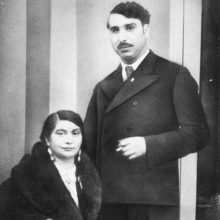
08 | Elise Strauss was murdered in Auschwitz. Four of her seven children died there too. Her husband Ewald survived and was liberated. Documentation Centre Archives
08

09 | Sonja, Eva and Agathe Friedrich were sent to Ravensbrück concentration camp before the ‘liquidation’ of the Auschwitz-Birkenau ‘gypsy camp’. There Sonja (left), who was only 13 years old at the time, was forcibly sterilised. The three girls survived and were liberated from Bergen-Belsen. Documentation Centre Archives
09
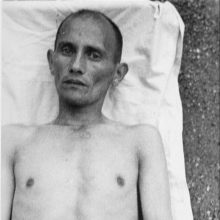
10.1 | Sinti and Roma as victims of medical experiments conducted at Dachau concentration camp on the drinkability of seawater. The photos were taken during the experiments. United States Holocaust Memorial Museum, National Archives and Records Administration, College Park, Md. The photo is cropped.
10.1

10.2 | Sinti and Roma as victims of medical experiments conducted at Dachau concentration camp on the drinkability of seawater. The photos were taken during the experiments. United States Holocaust Memorial Museum, National Archives and Records Administration, College Park, Md. The photo is cropped.
10.2

11 | Karl Höllenreiner, seen here in a photograph taken in Munich in the early 1930s (right), was maltreated at Dachau concentration camp for medical experiments on the drinkability of seawater. His sister Rosa (centre) lost her children at Auschwitz. Both survived the genocide. Karl Höllenreiner testified as a witness at the Nuremberg Doctors’ Trial. […]
11
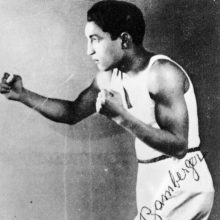
12.1 | Jakob Bamberger, runner-up in the flyweight category at the German boxing championships in 1938 and 1939, was also maltreated in seawater experiments at Dachau concentration camp. Documentation Centre Archives
12.1
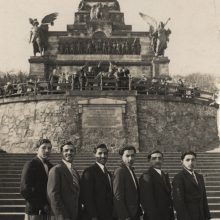
12.2 | This photograph shows Jakob Bamberger with friends at the ‘Deutsches Eck’ in Koblenz (Jakob Bamberger is on the far right, 1930s). Documentation Centre Archives
12.2

13 | Vinzenz Rose is one of the very few prisoners who managed to escape from a concentration camp. From Auschwitz-Birkenau he was sent to Natzweiler concentration camp, where he was maltreated by doctors conducting medical typhus experiments. From there he was sent to the Neckarelz subcamp in April 1944. His brother Oskar Rose managed […]
13

14.1 | Frank Steinbach (pictured) and Alfred Friedrich (next photo) were sent from Auschwitz to Sachsenhausen via Ravensbrück and managed to escape during a death march shortly before the end of the war. Documentation Centre Archives
14.1

14.2 | Frank Steinbach (photo before) and Alfred Friedrich (pictured) were sent from Auschwitz to Sachsenhausen via Ravensbrück and managed to escape during a death march shortly before the end of the war. Documentation Centre Archives
14.2

15 | Sofie Höllenreiner with her children before their deportation to Auschwitz. She was liberated from Bergen-Belsen by British troops. Documentation Centre Archives
15
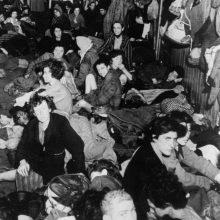
16 | Liberated Sinti and Roma in one of the barracks at Bergen-Belsen concentration camp Imperial War Museum, London
16

17.1 | Sylvester Lampert survived the concentration camps at Auschwitz, Natzweiler-Strutthof (where he was maltreated for medical experiments), Neckarelz and Dachau. He managed to escape while on a ‘death march’. The photograph on the left shows him in a work corps uniform prior to his deportation; the following photograph shows him in his prisoner’s uniform […]
17.1

17.2 | Sylvester Lampert survived the concentration camps at Auschwitz, Natzweiler-Strutthof (where he was maltreated for medical experiments), Neckarelz and Dachau. He managed to escape while on a ‘death march’. This photograph shows him in his prisoner’s uniform shortly after his liberation. Documentation Centre Archives
17.2

19 | Interview with Max Lauenburger (*1924) Max Lauenburger was liberated from the concentration camp Bergen-Belsen by British troops in April 1945. Despite the immediate rescue measures, many liberated prisoners continued to die as the result of malnutrition and diseases.
19

20 | Letter from the Standortarzt [chief camp physician] of the Waffen-SS at Buchenwald concentration camp dated 5 August 1944: ‘Re: gypsy transport of 3.8.1944 from Auschwitz concentration camp’ LATh – HStA Weimar, concentration camps and prisons Buchenwald No. 10, page 46r.
20
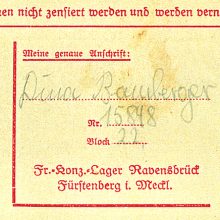
21.1 | Letter from Dina Bamberger from Ravensbrück concentration camp, with SS censorship annotation. The notice of her death is dated March 1944. Documentation Centre Archives
21.1
